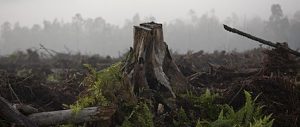High above the village of Nawroz Baba, above the shrine, even above the pastures, is the forest. It stretches to the snowy peaks on the skyline.
Ghulam Rasool Dar, who says he is somewhere between 60 and 70 years old but cannot be sure, remembers when the thick stands of fragrant pine reached down to the valley too.
"We are not happy about the future," Dar, the cleric of this tiny hamlet high in the Pir Panjal mountains, says. "We are worried about our woods."
The shepherds who live here are partly to blame, Dar admits. For decades they have cut timber to make their homes. But "only enough for our needs", he says.
For the real problem in Kharg, and more broadly in Kashmir, is recent. The insurgency that has wracked the region for two decades is at low ebb and an economic boom, in part fuelled by cash poured in by central government to win hearts and minds, has meant a voracious appetite for wood for new homes, hotels and other construction.
Although there is officially licensed government wood available, a huge black market of "timber smuggling" has sprung up as a result. "The problem is both substantial and widespread," said Dr Shaqil Rumshoo, an expert at Kashmir University, Srinagar. "There are all sorts of different players."
The smuggling industry involves corrupt bureaucrats, relatives of ministers and wealthy merchants. It is they who make the real money: tens of millions of dollars a year by some estimates.
On the ground, however, it is people such as Naseer Ahmed Sheikh who are doing the axe-work, chopping down trees above Nawroz Baba and selling the wood to middle men. Sheikh, 22, comes from one of the villages that suffer high unemployment lower down the steep slopes. He and his friends are paid around 2,000 rupees (US$43) for every tree they cut – a significant sum locally – but say they have to pay at least half of that that in bribes to forestry department officials and the police.
Prime protected wood from the increasingly rare deodar trees can fetch five times more but with much higher bribes to pay. As felling a tree takes only an hour or so, the loggers say, a few days work can bring in handsome sums.
"There’s no other work, so what can we do?” asked Sheikh, 22. "We have to feed our families."
An already weak local administration has been undermined by years of conflict and corruption. As elsewhere in India, strict laws to protect forests are rarely enforced. Many accuse the Forestry Department itself of being in league with the smugglers, a charge that officials deny.
"There is a major problem of political complicity," said Naeem Akhtar, until recently a senior bureaucrat in the Jammu and Kashmir ministry of tourism. "There is one area which was exceptionally beautiful, with huge tourist potential. If you go there, you can see a massacre of the trees right from the last village as far as the horizon."
There are efforts under way to save the forests. One new initiative is run by Carin Fischer, a German-American consultant for the state’s tourism ministry. Fischer, who has already successfully run a similar project in India’s remote north-east, is trying to turn the timber cutters of Kharg into trekking guides because as violence wanes, much of Kashmir’s rugged but famously beautiful terrain is becoming accessible for the first time in 20 years or more.
"You need to give the [cutters] some other livelihood," Fischer said. "If they are arrested they either get released by local politicians who buy the wood or they go straight back to it when they get out of prison."
In June, Fischer ran her first trek near Kharg on trails once used by militants infiltrating from Pakistan. The aims were to research suitable itineraries and to recruit 50 local men, most currently involved in timber cutting and smuggling, to be guides.
Few had seen a westerner before Fischer visited the village. "Smuggling is illegal, so we would rather not do it, and no one respects it as a job," said Tahir Mushir, 18. "Being a guide would be much better, even if we make a bit less money."
Though the trek went well, significant problems remain. An early bid to set up a similar project was blocked by local political rivalries and by powerful individuals linked to the smuggling. And though Kashmir is much calmer than it was even a few years ago, more than 150 security-force members, "terrorists" and civilians have been killed this year.
Demonstrations by stone-throwing teenagers protesting at what they say is Delhi’s refusal to allow Kashmiris to decide their own political future have become a daily occurrence. Fischer and her team admit the scenes of violence could put off tourists.
"Kashmir has shifted from being dangerous to inconvenient. It’s not a war zone. You may have some problems with a curfew but nothing you can’t figure out," said Michael Matheke, an international ski guide and development worker who led the June trek.
Fischer’s aims are modest. She hopes to divert some local people from the illicit timber business and to raise consciousness about how deforestation can contribute to other problems in rural areas, such as soil erosion and flash-flooding. "It may not be a solution but it is a start," she said.
Others, too, are campaigning, using India’s "right to information" law to force bureaucrats and the police to disclose details of investigations and prosecutions for timber smuggling.
Local activists are concentrating on Kharg. Already, there have been attempts to silence them. "This is where the problem is the worst in Kashmir. Three or four powerful local people have hijacked everything for their own interests here," said one. "But they cannot muzzle us. More and more people are joining us."
But time is running out. No scientific mapping of the forests means there is no way of gauging the damage already done.
"It is an environmental catastrophe," said one local environmental expert who preferred to remain anonymous due to fear of "powerful local players" involved in the timber smuggling business. "Some of these forests are very old and virtually irreplaceable."
The cutters themselves say they know the forests are thinner than they once were.
"Once there were lots of beasts and it was very dark and frightening," said Abdul Rasheed, 30, who supports 12 people and has no other work. "Now there is much more light in the forests and much less wild animals."
www.guardian.co.uk/
Copyright © Guardian News and Media Limited 2010
Carbon crime
Deforestation accounts for between 12% and 15% of the world’s carbon emissions, making it the second largest man-made source after burning fossil fuels. The rate of deforestation since the turn of the 21st century is 13 million hectares a year – equivalent to the size of England within the United Kingdom.
Forests currently store more than double the amount of carbon present in the atmosphere. Halting deforestation is considered the cheapest way to save carbon dioxide being released into the atmosphere.
The European Union trade in illegal timber is worth US$3.2 billion. But a newly agreed EU law, which will come into force in 2012, will ban illegal timber from being sold in the 27-nation community. The United Kingdom is the third-largest importer of illegal wood products in the world after China and Japan.
— By Christine Ottery
www.guardian.co.uk/
Copyright © Guardian News and Media Limited 2010
Homepage image from hpk


